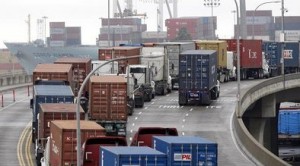 If you live anywhere near the Ports of Long Beach or Los Angeles – or any of the 29 west coast ports – you might notice that the cargo ships appear to be backed up farther down the coastline than usual. While the global economy is getting better, that extension of ships has more to do with bitter contract negotiations over the past nine months. It was backed up even more this past weekend after a shutdown by port operators.
If you live anywhere near the Ports of Long Beach or Los Angeles – or any of the 29 west coast ports – you might notice that the cargo ships appear to be backed up farther down the coastline than usual. While the global economy is getting better, that extension of ships has more to do with bitter contract negotiations over the past nine months. It was backed up even more this past weekend after a shutdown by port operators.
The International Longshore and Warehouse Union (ILWU) says that employers are not managing the supply chain efficiently; the Pacific Maritime Association, which represents shippers and terminal operators, says that union works have intentionally been slowing their work speed by about 50% to put pressure on management to settle the contract. Pacific Maritime Association put out a “best offer” proposal on Feb. 4 and is waiting for the union to respond.
Union members have been offered a 3% wage increase, 11% higher pension benefits and no pressure to make concessions on the contract. For workers in the region, it’s usually the highest paying job out there. Longshore workers are now approaching $150,000 in annual wages and pensions that average $80,000 a year. There is a price for living that life – injuries can be severe for ILWU members, air quality can cause respiratory health problems, and the traffic congestion in and around the ports has been getting worse.
Port of Long Beach Chief Executive Jon Slangerup said during his State of the Port address on January 29 that congestion is becoming a serious problem at the port. It goes back to about 18 months ago when ocean carrier lines formed alliances combining their cargo ships. These ocean carriers got out of the truck trailer chassis side of the business; three local leasing companies took on the work but didn’t have large enough fleets to cope with increasing demand from these massive vessel carriers. Storing containers and getting them to trucks and trains became more complicated and dragged out as well.
The Port of Long Beach has been in discussions with the unions and the Port of Los Angeles on finding solutions to these gridlock problems. Capital investments are underway such as the Middle Harbor Redevelopment Project and the Gerald Desmond Bridge Replacement Project have been underway, and Slangerup expects them to generate about 5,000 construction jobs over the next few years.
The ports have been considering other capital investments in recent years, including one that would efficiently stack cargo containers and load them onto railroad cars that would deliver them to trucks near downtown Los Angeles. That proposal has been based on air pollution and traffic congestion building up on the I-710 and I-110 freeways. There’s also been the I-710 Corridor Project that’s expected to start up in the next five years. That 12-mile project is still seeking buy-in from cities along that stretch of the freeway and government agencies overseeing the region. The concept is to launch the corridor project in 2020 and complete it in 2030; it’s expected to create 500,000 project jobs and to help reduce harmful emissions.
The Port of Long Beach last night celebrated the 10 year anniversary of its Green Port Policy – which has been embraced and replicated by other ports around the world; the board voted to continue supporting the Green Port Policy through its next phase. The Port of Long Beach has invested more than $500 million to reduce the port’s environmental impact and meet ambitious goals improving air, water, soil and sediments, wildlife, sustainability, and community engagement. Slangerup emphasized the goal of making Long Beach the world’s first zero emission port. Much of that is coming through what the port calls “Energy Island,” a fully self-sustained energy grid powered by solar, wind, fuel cells, natural gas, and potentially with other technologies currently in development.
Trucking has been a big part of the Green Port Policy for the second largest source of air pollution after cargo ships. The Ports of Long Beach and Los Angeles enacted their Clean Trucks programs that have brought the trucking fleets up to newer, cleaner diesel engines and reduced air pollution 80% compared to older truck models. Both ports are supporting test projects for port drayage trucks and other vehicles – such as battery electric trucks.
There’s much hope out there for peaceful settlement of the union contracts, and relief from congestion in the ports and nearby areas. The next 20 years will see several ambitious projects enacted to deal with these challenges and the health risks from increasing air pollution. The opportunities are there for all port stakeholders willing to take them on.

